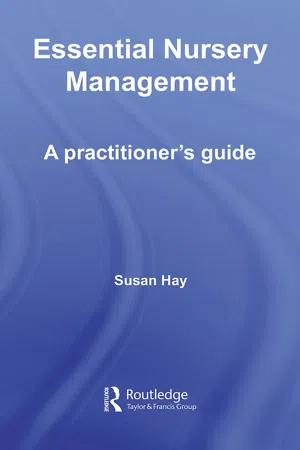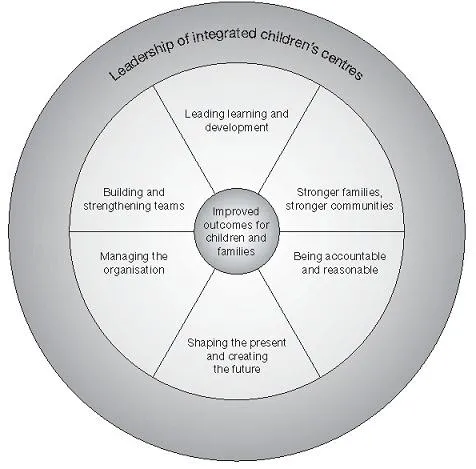Chapter 1
Who is a manager and what is management?
- Management and leadership
- Fit to manage in the eyes of others
- Manager’s rite of passage
- Maturing as a manager
- Are nursery managers born or are they made?
- Trust in leadership
Leaders are called to stand in that lonely place between the no longer and the not yet and intentionally make decisions that will bind, forge, move and create history.
We are not called to be popular, we are not called to be safe, we are not called to follow. We are the ones called to take risks, we are the ones called to change attitudes; to risk displeasure. We are the ones called to gamble our lives for a better world.
Mary Lou Anderson, Address to the
House of Delegates, April 1970
The success of a nursery will depend on a range of factors but it is clear that there will be a heavy reliance on the quality of its leadership. A frequently-quoted belief is that 80 per cent of deficiencies in nursery services relate to weaknesses in leadership.This may be a generalisation; however, there is no doubt that strong and effective leaders are critical in securing good outcomes for children and families.
MANAGEMENT AND LEADERSHIP
People who are selected or are identified as nursery managers are used to managing. The care and education of young children inevitably requires organisational skills, setting expectations of behaviour, maintaining standards, evaluating outcomes – all the issues normally covered in professional qualifications and training for nursery nurses and teachers. However, this innate experience does not seem to translate easily when it comes to applying it to the nursery as a whole, and it does not necessarily translate into leadership.
Management of a nursery, in my view, encompasses both management as it is usually thought of, and leadership – which is generally believed to be something broader than management. Leaders are people who can influence the behaviour of others for the purpose of achieving a goal. Leaders possess a special set of rather baffling qualities that enable them to persuade others to do what the leader wants because they want to do it. Leaders can balance concern for the task, for quality and for efficiency, with equal concern for the people they work with and the relationships between them.
Managers are understood to be concerned with routine and focusing on the present.Their actions are usually dominated by issues of continuity and stability, and they are responsible for efficient control of finance, for sensitive management of staff and families, and for maintaining the reputation of the nursery. There are now a number of management qualifications offered that complement nursery nursing, and employers will increasingly expect manager candidates to have achieved such a qualification.Acquiring a qualification to lead is more elusive.The differences between leadership and management have been noted by Hodgkinson (1991)*:
- leadership is an art whereas management is a science;
- leadership is focused on policy whereas management is concerned with execution;
- leadership is concerned with values whereas management looks at facts;
- leadership is generalist, management is specialist;
- leadership uses broad strategies rather than management’s specific tactics;
- leadership is concerned with philosophy rather than action;
- leaders are reflective, managers are active;
- leaders are concerned with human resources whereas managers are concerned with material resources;
- leaders focus on deliberation, managers on detail.
In most nursery settings the manager is indeed required also to be the leader.The financial constraints of having two people at this level usually require both roles to be filled by the same individual and it is probably only within the larger nursery groups that you begin to see the distinction emerge.The syndrome of having to deal with both roles is often described by management consultants as management of the ‘important versus the immediate’, where important refers to those big value-based issues with which a leader is concerned, vying for time with the manager’s need to respond to day-to-day problems that constantly arise.
While it is true that in order to be an effective leader you need to be an efficient manager, management skills do not equate with leadership skills – they are much wider. Also, although having highly developed management skills will probably allow you to create time for leadership functions as well, having poorly developed management skills will inevitably prohibit attention being paid to leadership functions. This book uses ‘management’ to describe the combination of leadership and management required in nursery settings. However, with the advent of nursery groups, including those operated within schools and Children’s Centres, the nursery is often part of a group, with a support network of regional management that limits the extent of leadership expected of the nursery manager. The relationship between the manager and those who are identified as leaders then needs careful attention, and must be clearly communicated.
Illustrating how leadership and management come together for those in early years’ services, Gillian Rodd (1994)* lists the essential characteristics for the job:
- Curiosity (interest in learning);
- Candour (open to public scrutiny and willingness to speak the truth);
- Courtesy (respect and dignity for others);
- Courage (willingness to take risks, dare, make mistakes);
- Compassion (creating trust and empathy).
But there is an alternative view of leadership, which is that unlike the manager, a leader can exist at any and all levels in a nursery team.‘Leaderful teams’ is a concept developed at Pen Green Research, Development & Training Base and Leadership Centre, and discussed at more length in Chapter 3: Leading a team and managing a service.
It would also be argued by many that a nursery manager’s role should embrace all those responsibilities traditionally associated with leaders, and that the edges between the two are blurred, i.e. a good manager must also be a good leader. Indeed, under the Every Child Matters* agenda, the DFES (Department for Education and Skills) identifies seven aspects of management/leadership as necessary core competencies in championing children, a shared set of skills, knowledge and behaviours for those leading and managing integrated children’s services (2005):
- achieving outcomes;
- safeguarding and promoting the welfare of the child;
- providing direction;
- leading and managing change;
- working with people;
- managing information;
- communicating and engaging effectively with children, young people and families.
This development can also be evidenced in recent initiatives such as the National Standards for Leadership of Children’s Centres, published in spring 2007 by the National College for School Leadership (NCSL)*. The standards are grouped into six key areas, which are both interdependent and of equal importance, and come together around the essential purpose to improve outcomes for children and families (see Figure 1.1).
▪ Figure 1.1 NCSL*: National Standards for Leadership of Children's Centres
Source: National College for Schools Leadership
NCH, the National Children’s Charity, formerly, National Children’s Home, considers that leadership and management must be combined in the role of nursery manager in order to maintain a culture that remains true to its values of having a sustainable future, delivers high performance and demonstrates the value placed on each person’s contribution:
- providing leadership and direction;
- working in partnership;
- delivering excellent results;
- motivating and managing people;
- making a personal impact;
- being accountable;
- learning and sharing.
This new approach to the role of the head of a nursery has been largely driven by the evolution of the Children’s Centre programme within the Every Child Matters* agenda that by definition requires a broader and higher level of professional expertise and aptitude than has been expected before, both by regulators and parents. Even though some nurseries may consider that they are not asking the same of their managers, there should be no difference in the sense of responsibility that the post holder feels and takes on: children, families and staff deserve no less from the individual in charge on a day-to-day basis. All nurseries need to be aspirational, if only to compete in the recruitment market for the best staff.
FIT TO MANAGE IN THE EYES OF OTHERS
The National Children’s Bureau’s (NCB) Guidelines for Good Practice in Group Daycare (1991)* describes the management responsibility as:
- ensuring that the nursery is operating smoothly;
- responding to the needs of parents, children and staff;
- being open to suggestions for development.
These three points encapsulate the essential needs for:
- policies and procedures to be understood and followed;
- staff to be empowered to make decisions that are flexible to changing needs;
- recognition that new knowledge and new ideas need to be continuously assessed and incorporated into practice.
Each of these three concepts requires the manager to learn continuously: from mistakes, from other people, and from other ways of going about running a nursery.
When we combine the need for learning, and the need to develop directing ability, we create the idea of the learning leader. This is a more appropriate title for the person responsible for ensuring that the NCB Guidelines are met; that the service is managed in a way appropriate to a changing profile of children, a changing profile of parents, a changing staff team, new thought on how children develop, and new legislation.
The first stage is to learn from what is actually going on in your nursery. If we reflect on the circumstances that lead to such tragedies as the deaths of Victoria Climbie, and Ellie Lawrenson, they become more disturbing because the knowledge necessary to avoid this tragic loss of human life lay within the hands of those responsible. If there is no system for sharing information, no real means of learning from previous experience, no process for listening to feedback from stakeholders and for communicating all this to those responsible for taking preventive action, then avoidable errors will occur.
In a nursery setting, when information does not flow freely and openly in the interests of children and parents, this can be characterised as ‘oh I thought she was doing that’ or ‘if only you’d told me that earlier’ – all contributing to destroying cooperation, encouraging buck passing and undermining instructions.
The first step for a new manager, then, is to create or review the learning system by which the nursery can become both more effective and more efficient. This combines the written policies and procedures, and routines for review and evaluation of practice. Both these issues are dealt with in Chapter 2.
OFSTED has a specific view, for the purposes of registering and inspecting a nursery under the Children Act, of what makes a manager and the directors of an organisation ‘fit’, and this should be regarded as the baseline for competence in the role.
MANAGER’S RITE OF PASSAGE
The second step is for the manager to go through an important rite of passage:
You are now so valuable to us, that you must leave the day-to-day operation of the organisation, and have time and space to think about how effective we are in relation to the changing entitlements and needs of children and parents, what the future of those changes might mean, how we can position ourselves strategically and...


